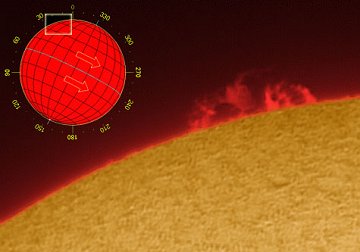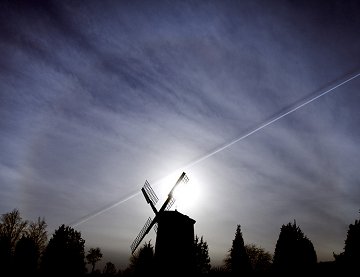 Did you miss last night's auroras? Next time get a wake-up call from Spaceweather PHONE.
Did you miss last night's auroras? Next time get a wake-up call from Spaceweather PHONE.
ASTEROID FLYBY: On April 16th, asteroid 2007 GU1 will fly past Earth. There's no danger of a collision. The 50 meter-wide space rock will be 500,000 miles away at closest approach, about twice the distance to the Moon. An asteroid about this size may have caused the Tunguska explosion of 1908 when a meteoritic airburst leveled 800 sq. miles of Siberian forest. Such an impact occurs every thousand years or so, researchers believe. This, fortunately, is one of the misses.
BLANK SUN: The sun is entering its 11th day in a row with no sunspots. This marks the longest string of blank suns since 1996. That was a year of deep solar minimum, featuring blank intervals as long as 37 days. 2007 is shaping up to be the same--a deep nadir of the solar cycle.
Of course, blank is in the eye of the beholder. Although the sun has no spots, there are "several nice prominences visible today," reports Pete Lawrence of Selsey, UK. "Here's a shot of the largest one:"

Photo details: Coronado PST, Lumenera SKYnyx 2-0M, 3x Barlow pushed to ~4x
Meanwhile, in Ath, Belgium, Joel Bavais made a 60-minute movie of one of the prominences he saw while looking through his SolarMax60 solar telescope. "It's fantastic to see the evolution of this prominence," he says. Despite the low sunspot number, "our Sun is alive!"
more images: from Cai-Uso Wohler of Bispingen, Germany; from from P-M Hedén of Vallentuna, Sweden; from Pavol Rapavy of Rimavska Sobota, Slovakia; from Robert Arnold on the Isle of Skye, Scotland;
SHADOWGRAPH IN THE SKY: On April 8th, P-M Hedén of Vallentuna, Sweden, was photographing a sun halo when "an aeroplane went by and left a condensation trail across the halo. The shadow of the contrail created a nice 3D feeling."
Quiz: Which is higher, the halo or the contrail? Find the answer below.

Photo details: Canon Digital Rebel XT & 20mm Sigma EX DG on a tripod.
"Our eyes and brains often play tricks on us," says atmospheric optics expert Les Cowley. "The sun seems to be a nearby lamp casting the shadow of the contrail upwards onto higher clouds. Not so! The layer of cirrus forming the circular 22° ice halo is 3 to 6 miles high. However, the contrail is even higher and the sun is casting a shadow downwards onto the thin screen-like cloud."

